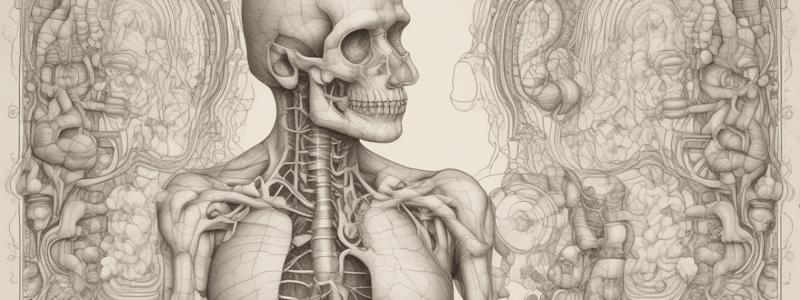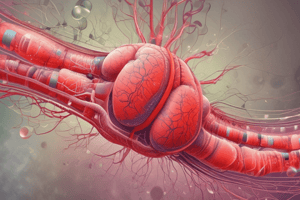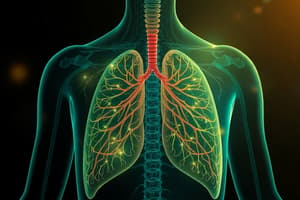Podcast
Questions and Answers
What does the respiratory system deal with?
What does the respiratory system deal with?
- Transporting oxygen and nitrogen
- Maintaining the homeostasis of O2, CO2, and H2 gases (correct)
- Regulating blood pressure
- Producing red blood cells
Which gases does the respiratory system regulate to maintain Arterial Blood Gases (ABGs)?
Which gases does the respiratory system regulate to maintain Arterial Blood Gases (ABGs)?
- O2, CO2, and H2 (correct)
- O2, N2, and H2O
- CO2, O3, and H2O
- CO, H2, and N2
How many ATP are produced when 1 glucose molecule enters the mitochondria, in the presence of O2?
How many ATP are produced when 1 glucose molecule enters the mitochondria, in the presence of O2?
- 36 ATP (correct)
- 30 ATP
- 28 ATP
- 40 ATP
What is the primary purpose of maintaining Arterial Blood Gases (ABGs) by the respiratory system?
What is the primary purpose of maintaining Arterial Blood Gases (ABGs) by the respiratory system?
What is the final ATP yield when pyruvate enters the mitochondria with the presence of O2?
What is the final ATP yield when pyruvate enters the mitochondria with the presence of O2?
Which of the following is NOT a gas that the respiratory system maintains?
Which of the following is NOT a gas that the respiratory system maintains?
If a process results in the production of 37 ATP from 1 glucose molecule, what could be a possible explanation for this discrepancy?
If a process results in the production of 37 ATP from 1 glucose molecule, what could be a possible explanation for this discrepancy?
Why is maintaining the homeostasis of gases essential for the body?
Why is maintaining the homeostasis of gases essential for the body?
In the absence of oxygen, what is the estimated ATP production from 1 glucose molecule?
In the absence of oxygen, what is the estimated ATP production from 1 glucose molecule?
If a cell undergoes glycolysis without subsequent entry into the mitochondria, what is the maximum potential ATP yield from 1 glucose molecule?
If a cell undergoes glycolysis without subsequent entry into the mitochondria, what is the maximum potential ATP yield from 1 glucose molecule?
Where does obstruction occur?
Where does obstruction occur?
Which part of the respiratory system is associated with restriction?
Which part of the respiratory system is associated with restriction?
What is primarily affected in obstruction?
What is primarily affected in obstruction?
Which part of the respiratory system is mainly involved in restriction?
Which part of the respiratory system is mainly involved in restriction?
Where do issues related to obstruction typically manifest?
Where do issues related to obstruction typically manifest?
Which zone diseases are the most common among lung diseases?
Which zone diseases are the most common among lung diseases?
Which type of lung disease is associated with a restriction pattern?
Which type of lung disease is associated with a restriction pattern?
Why is CO2 more diffusible than O2 across biological membranes?
Why is CO2 more diffusible than O2 across biological membranes?
In comparison to oxygen, what factor contributes to the easier diffusion of carbon dioxide?
In comparison to oxygen, what factor contributes to the easier diffusion of carbon dioxide?
What is a common example of a conducting zone disease in the lungs?
What is a common example of a conducting zone disease in the lungs?
What percentage of lung diseases are related to vascular zone diseases?
What percentage of lung diseases are related to vascular zone diseases?
Which type of lung disease is exemplified by pulmonary hypertension?
Which type of lung disease is exemplified by pulmonary hypertension?
What makes oxygen not diffusion limited when crossing biological membranes?
What makes oxygen not diffusion limited when crossing biological membranes?
Which statement best explains why hypoxia is unlikely due to diffusion problems?
Which statement best explains why hypoxia is unlikely due to diffusion problems?
What characteristic of carbon dioxide enables it to diffuse 20 times easier than oxygen?
What characteristic of carbon dioxide enables it to diffuse 20 times easier than oxygen?
Which gas is affected in respiratory failure type 1?
Which gas is affected in respiratory failure type 1?
In respiratory failure type 2, which gases are affected?
In respiratory failure type 2, which gases are affected?
Which gas is NOT primarily affected in respiratory failure type 1?
Which gas is NOT primarily affected in respiratory failure type 1?
What happens to carbon dioxide levels in respiratory failure type 2?
What happens to carbon dioxide levels in respiratory failure type 2?
Which gas is not mentioned as being affected in any type of respiratory failure?
Which gas is not mentioned as being affected in any type of respiratory failure?
In respiratory failure type 2, what happens to the levels of both oxygen and carbon dioxide?
In respiratory failure type 2, what happens to the levels of both oxygen and carbon dioxide?
What is the total number of layers that make up the Respiratory Membrane?
What is the total number of layers that make up the Respiratory Membrane?
In respiratory failure type 1, what gas experiences a significant impact?
In respiratory failure type 1, what gas experiences a significant impact?
Which of the following is NOT mentioned as part of the Respiratory Membrane?
Which of the following is NOT mentioned as part of the Respiratory Membrane?
What must cross the 6 layers of the Respiratory Membrane according to the text?
What must cross the 6 layers of the Respiratory Membrane according to the text?
Which issue in the respiratory system is exemplified by the presence of pulmonary hypertension?
Which issue in the respiratory system is exemplified by the presence of pulmonary hypertension?
Which gas is primarily affected first in the lungs when there is a problem, according to the text?
Which gas is primarily affected first in the lungs when there is a problem, according to the text?
What factor contributes to the less diffusibility of O2 compared to other gases, as stated in the text?
What factor contributes to the less diffusibility of O2 compared to other gases, as stated in the text?
In respiratory failure type 1, which gas is NOT primarily affected according to the text?
In respiratory failure type 1, which gas is NOT primarily affected according to the text?
What is a common example of a restriction pattern lung disease, based on the information given?
What is a common example of a restriction pattern lung disease, based on the information given?
Which gas, apart from O2, is mentioned as less diffusible across biological membranes in the provided text?
Which gas, apart from O2, is mentioned as less diffusible across biological membranes in the provided text?
What drives the process of oxygen diffusion from the pulmonary artery to the right atrium?
What drives the process of oxygen diffusion from the pulmonary artery to the right atrium?
In which direction does oxygen diffuse when moving from the right ventricle to the pulmonary artery?
In which direction does oxygen diffuse when moving from the right ventricle to the pulmonary artery?
What factor determines the direction of oxygen diffusion between the right atrium and the right ventricle?
What factor determines the direction of oxygen diffusion between the right atrium and the right ventricle?
Which vessel has a lower partial pressure of oxygen compared to the right ventricle in this scenario?
Which vessel has a lower partial pressure of oxygen compared to the right ventricle in this scenario?
What is the main driving force for the movement of oxygen molecules between the right atrium and the right ventricle?
What is the main driving force for the movement of oxygen molecules between the right atrium and the right ventricle?
Why is O2 mainly focused on in the context provided?
Why is O2 mainly focused on in the context provided?
Which factor contributes to the significance of O2 in cellular life?
Which factor contributes to the significance of O2 in cellular life?
What is the primary reason for considering O2 as essential for cells?
What is the primary reason for considering O2 as essential for cells?
Why do cells require O2 according to the context?
Why do cells require O2 according to the context?
What role does O2 play in the context of cellular life?
What role does O2 play in the context of cellular life?
What happens to the partial pressure of oxygen (PaO2) as oxygen diffuses from arterioles to interstitial in the given scenario?
What happens to the partial pressure of oxygen (PaO2) as oxygen diffuses from arterioles to interstitial in the given scenario?
Which gas has a higher partial pressure in the given scenario: oxygen in the circulation (PaO2= 100mmHg) or oxygen in the interstitial (PiO2= 40mmHg)?
Which gas has a higher partial pressure in the given scenario: oxygen in the circulation (PaO2= 100mmHg) or oxygen in the interstitial (PiO2= 40mmHg)?
What is the direction of oxygen diffusion when PiO2= 40mmHg and PaO2= 100mmHg?
What is the direction of oxygen diffusion when PiO2= 40mmHg and PaO2= 100mmHg?
In the process of oxygen diffusion, what factor determines the net movement of oxygen molecules?
In the process of oxygen diffusion, what factor determines the net movement of oxygen molecules?
How does the difference in partial pressures of oxygen (PaO2) and interstitial oxygen (PiO2) influence the rate of oxygen diffusion between arterioles and interstitial?
How does the difference in partial pressures of oxygen (PaO2) and interstitial oxygen (PiO2) influence the rate of oxygen diffusion between arterioles and interstitial?
If the pressure in A = the pressure in B, what is the resulting driving force for flow?
If the pressure in A = the pressure in B, what is the resulting driving force for flow?
In the context provided, what happens to flow when the driving force is zero?
In the context provided, what happens to flow when the driving force is zero?
What is the outcome of ΔP (Driving Force) being zero in a system where A = B?
What is the outcome of ΔP (Driving Force) being zero in a system where A = B?
How does the equality of pressures in A and B impact the movement of substances between them?
How does the equality of pressures in A and B impact the movement of substances between them?
What is the significance of ΔP being zero when comparing pressures in A and B?
What is the significance of ΔP being zero when comparing pressures in A and B?
What does the term 'Inspiration Capacity (IC)' refer to?
What does the term 'Inspiration Capacity (IC)' refer to?
Which lung disease is characterized by a restriction pattern based on the information provided?
Which lung disease is characterized by a restriction pattern based on the information provided?
What is the primary function of the Inspiration Capacity (IC) in the context of lung diseases?
What is the primary function of the Inspiration Capacity (IC) in the context of lung diseases?
In pulmonary function testing, what would a lower-than-expected Inspiration Capacity (IC) indicate?
In pulmonary function testing, what would a lower-than-expected Inspiration Capacity (IC) indicate?
How is 'Inspiration Capacity (IC)' related to lung health?
How is 'Inspiration Capacity (IC)' related to lung health?
What happens to Palv during negative Pressure Breathing?
What happens to Palv during negative Pressure Breathing?
In the artificial pattern of breathing 2, what is the specific mechanism mentioned?
In the artificial pattern of breathing 2, what is the specific mechanism mentioned?
What kind of pressure mechanism is employed in the described breathing pattern?
What kind of pressure mechanism is employed in the described breathing pattern?
How does the artificial pattern of breathing 2 differ from standard breathing?
How does the artificial pattern of breathing 2 differ from standard breathing?
What characterizes the breathing mechanism in the context of Palv and Patm?
What characterizes the breathing mechanism in the context of Palv and Patm?
Can the Pulmonary Diffusing System (PDS) be smaller than the Alveolar Diffusing System (ADS)?
Can the Pulmonary Diffusing System (PDS) be smaller than the Alveolar Diffusing System (ADS)?
What contributes to the significance of oxygen in cellular life?
What contributes to the significance of oxygen in cellular life?
Why is hypoxia unlikely due to diffusion problems?
Why is hypoxia unlikely due to diffusion problems?
What happens to carbon dioxide levels in respiratory failure type 2?
What happens to carbon dioxide levels in respiratory failure type 2?
Which factor determines the direction of oxygen diffusion between the right atrium and right ventricle?
Which factor determines the direction of oxygen diffusion between the right atrium and right ventricle?
What is the reference pressure in mmHg mentioned in the text?
What is the reference pressure in mmHg mentioned in the text?
In the context provided, when the Patm is stated to be zero, what approximate value in mmHg does it represent?
In the context provided, when the Patm is stated to be zero, what approximate value in mmHg does it represent?
How is 760 mmHg related to the statement 'here to avoid big numbers you have to consider it as zero'?
How is 760 mmHg related to the statement 'here to avoid big numbers you have to consider it as zero'?
When discussing pressure values relative to 760 mmHg, what does 'more or less than the actual number' mean?
When discussing pressure values relative to 760 mmHg, what does 'more or less than the actual number' mean?
What does the statement 'we'll use signs' suggest in the text?
What does the statement 'we'll use signs' suggest in the text?





